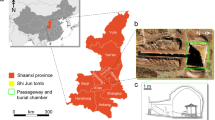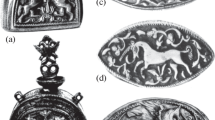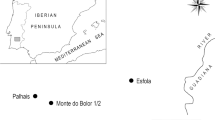Abstract
The study of gold jewellery can provide important answers about the diffusion of goldsmith technologies and cultural beliefs in Mediterranean World. This work comprises gold ornaments recovered from archaeological contexts dated to the 1st millennium BC in southern Portugal, with special emphasis to two exceptional plaques portraying the Mesopotamian iconography of the “tree of life”, in addition to two rings, the so-called nezems, whose prototype also derived from Orientalising contexts. The set of gold items is completed with a fragment of an ornament such as a pendant or earring. The jewellery was characterised by p-EDXRF, SEM–EDS and optical microscopy to identify the production techniques and composition, while the reflectance transformation imaging technique was used to enhance the study of iconographic motifs. Some manufacturing processes were identified, namely the decoration with stamping on the “tree of life” plaques, a technique similar to strip-drawing on the nezems and the brazing with Au–Ag–(Cu) solder on the small fragment. Overall, the set showed gold alloys with highly variable silver contents (11–39 wt%), but rather constant copper amounts (1.8–2.5 wt%). The composition of individual items helped to establish associations, such as the use of an identical alloy for the pair of plaques. Moreover, the two nezems were made with gold of different purity probably due to economic reasons. Finally, the gold alloy compositions were compared with others from different collections in Iberian Peninsula and Eastern Mediterranean region, providing clues about the gold alloys used by ancient goldsmith workshops.







Similar content being viewed by others
Data availability
Data will be made available on request.
References
Almagro-Gorbea M, Lorrio AJ, Mederos A, Torres M (2008) La necrópolis de Medellín. II. Estudio de los hallazgos. Real Academia de la Historia, Madrid
Araújo MF, Alves LC (1994) Análise por PIXE e XRF de alguns artefactos metálicos do Bronze do Sudoeste, in: Soares, A.M.M., O Bronze do Sudoeste na Margem Esquerda do Guadiana. As necrópoles do Concelho de Serpa, Actas das V Jornadas Arqueológicas da Associação dos Arqueólogos Portugueses, vol. 2, Associação dos Arqueólogos Portugueses, Lisboa, pp. 186–189
Arruda AM, Barbosa R, Gomes F, Sousa E (2016) A necrópole da Vinha das Caliças (Beja, Portugal), in: Jiménez Ávila J (Ed.), SIDEREUM ANA III. El río Guadiana y Tartessos, Consorcio Ciudad Monumental Histórico-Artística y Arqueológica de Mérida, Mérida, pp.187–225
Aubet ME (1978) Los marfiles fenicios del Bajo Guadalquivir: I. Cruz del Negro. Boletín Del Seminario De Estudios De Arte y Arqueología 44:15–88
Aubet ME (1980) Los marfiles fenicios del Bajo Guadalquivir: II. Acebuchal y Alcantarilla. Boletín Del Seminario De Estudios De Arte y Arqueología 46:33–92
Beirão CM, Gomes MV (1980) A I Idade do Ferro no Sul de Portugal – Epigrafia e Cultura. Museu Nacional de Arqueologia e Etnologia, Lisboa
Beirão CM, Gomes MV (1983) A necrópole da Idade do Ferro do Galeado (Vila Nova de Mil Fontes). O Arqueólogo Português, Série IV 1:207–272
Bittel K (1976) Los Hititas. Aguilar, Madrid
Bonizzoni L, Maloni A, Milazzo M (2006) Evaluation of effects of irregular shape on quantitative XRF analysis of metal objects. X-Ray Spectrom 35:390–399. https://doi.org/10.1002/xrs.926
Cojocaru V, Badica T, Popescu IV (2003) Natural gold composition studied by proton activation analysis. Romanian Rep Phys 55:460–463
Corregidor V, Dias R, Catarino N, Cruz C, Alves LC, Cruz J (2020) Arduino-controlled reflectance transformation imaging to the study of cultural heritage objects. SN Appl Sci 2:1586. https://doi.org/10.1007/s42452-020-03343-4
Correia JE (2005) Levantamento arqueológico da Freguesia de São Bartolomeu de Messines. Câmara Municipal de Silves, Silves
Correia VH (2018) An Iron Age gold workshop in southwest Iberia: reflections on Vaiamonte and other earrings. In: Schwab R, Milcent P-Y, Armbruster B, Pernicka E (eds) Early Iron Age Gold in Celtic Europe: Society. Technology and Archaeometry, Verlag Marie Leidorf, Rahden/Westf., pp 339–355
Ehser A, Borg G, Oliveira DPS, Rosa DRN, Salgueiro R (2011) Characterization of placer gold deposits from central Portugal: preliminary results, in: Barra, F. (Ed.), Let's Talk Ore Deposits: Proceedings of the 11th Biennial SGA Meeting, Universidad Católica del Norte, Antofagasta, pp. 814–816
Eluère C (1985) Goldwork of the Iron Age in `Barbarian’ Europe. Gold Bull 18(4):144–155. https://doi.org/10.1007/BF03214697
Eluère C (1989) A “gold connection” between the etruscans and early celts? Gold Bull 22(2):48–55. https://doi.org/10.1007/BF03214707
Eshel T, Tirosh O, Yahalom-Mack N, Gilboa A, Erel Y (2022) Silver isotopes in silver suggest Phoenician innovation in metal production. Appl Sci 12(2):741. https://doi.org/10.3390/app12020741
Garcia-Guinea J, Correcher V, Rojas RM, Fierro JLG, Fernandez-Martin C, López-Arce P, Rovira-Llorens S (2005) Chemical tracers in archaeological and natural gold: Aliseda Tartessos treasure and new discovered nuggets (SW Spain). Gold Bull 38(1):23–28. https://doi.org/10.1007/BF03215224
Gomes FB (2021) A necrópole do Olival do Senhor dos Mártires (Alcácer do Sal, Portugal). Práticas Funerárias, Cultura Material e Identidade(s) na Idade do Ferro do Baixo Sado (séculos VII-II a.n.e.). UNIARQ/FL-UL, Lisboa
González Prats A (1989) Dos bronces fenicios de la colección candela: aportación al conocimiento de la orfebrería e iconografía orientalizante de la Península Ibérica, in: Aubet Semmler, M.E. (Coord.), Tartessos. Arqueología Protohistórica del Bajo Guadalquivir, Ausa, Madrid, pp. 411–430
Guerra MF, Rehren T (2009) In-situ examination and analysis of the gold jewellery from the Phoenician tomb of Kition (Cyprus). ArcheoSciences 33:151–158. https://doi.org/10.4000/archeosciences.2148
Guerra MF, Bagault D, Borel T, Di Mantova A, Esquès C, Plé E (2007) Examen et analyse élémentaire de bijoux étrusques de la collection Campana. In: Gaultier F, Metzger C (eds) Les Bijoux de la Collection Campana: De L’Antique au Pastiche. École du Louvre, Paris, pp 145–177
Hackens T, Winkes R (1983) Gold Jewelry. Art and Archaeology Publications, Louvain-la-Neuve, Craft, Style and Meaning from Mycenae to Constantinopolis
Hough R, Butt C, Fischer-Bühner J (2009) The crystallography, metallography and composition of gold. Elements 5:297–302. https://doi.org/10.2113/gselements.5.5.297
Karidas AG, Kotzamani D, Bernard R, Barrandon JN, Zarkadas Ch (2004) A compositional study of a museum jewellery collection (7th-1st BC) by means of a portable XRF spectrometer. Nucl Inst Methods Phys Res B 226:15–28. https://doi.org/10.1016/j.nimb.2004.02.034
Kuleff I, Tonkova M, Stoyanov T (2009) Chemical composition of gold breast plates from ancient Thrace (5th - 4th century BC). Archaeologia Bulgarica 13(2):11–20
Lesigyarski D, Zlateva B, Lyubomirova V, Stoyanov T, Kuleff I (2015) Thracian golden wreath from Kabyle, Bulgaria: chemical composition. ArcheoSciences 39:149–156. https://doi.org/10.4000/archeosciences.4440
Liu Y, Yu J, Yang J, Li W (2021) Long-distance relationship with the Mediterranean World? Gold beech-nut pendants found in the Early Iron Age China and the Eurasian Steppe. Mediter Archaeol Archaeom 21(2):259–280. https://doi.org/10.5281/zenodo.5057564
María Blázquez J (1975) Tartessos y los Orígenes de la Colonización Fenicia en Occidente. Ediciones Universidad de Salamanca, Salamanca
Martín Ruiz JA, Fernández Reche S (2007) Jewelry from the Phoenician necropolises of Málaga. Spal 16:187–194. https://doi.org/10.12795/spal.2007.i16.09
Mello E, Parrini P, Formigli E (1983) Etruscan filigree: welding techniques of two gold bracelets from Vetulonia. Am J Archaeol 87(4):548–551. https://doi.org/10.2307/504114
Miguel L, Albuquerque P, Evangelista LS, Lourenço M (2019) Trabalhos arqueológicos na necrópole sidérica de Mértola: resultados preliminares das sondagens arqueológicas. Apontamentos De Arqueologia e Património 13:41–46
Montero I, Rovira S (1991) El oro y sus aleaciones en la orfebrería prerromana. Arch Esp Arqueol 64:7–21. https://doi.org/10.3989/aespa.1991.v64.496
Murillo-Barroso M, Eleazar Costa Caramé M, Díaz-Guardaminouribe M, GarcíaSanjuán L, Mora Molina C (2015) A reappraisal of Iberian Copper Age goldwork: craftmanship, symbolism and art in a non-funerary gold sheet from Valencina de la Concepción. Camb Archaeol J 25(3):565–596. https://doi.org/10.1017/S0959774314001127
Newbury DE, Ritchie NWM (2015) Performing elemental microanalysis with high accuracy and high precision by scanning electron microscopy/silicon drift detector energy-dispersive X-ray spectrometry (SEM/SDD-EDS). J Mater Sci 50:493–518. https://doi.org/10.1007/s10853-014-8685-2
Oddy A (1977) The production of gold wire in Antiquity. Handmaking methods before the introduction of the draw-plate. Gold Bull 10(3):79–87. https://doi.org/10.1007/BF03215438
Ortega-Feliu I, Gómez-Tubío B, Ontalba Salamanca MÁ, Respaldiza MÁ, Bandera ML, Ovejero Zappino G (2007) Gold and electrum jewellery in the strategic area of Gadir in Phoenician period. Nucl Instrum Methods Phys Res, Sect B 260(1):329–335. https://doi.org/10.1016/j.nimb.2007.02.077
Ortega-Feliu I, Scrivano S, Gómez-Tubío B, Ager FJ, Bandera ML, Respaldiza MA, Navarro AD, San Martín C (2018) Technical characterization of the necklace of El Carambolo hoard (Camas, Seville, Spain). Microchem J 139:401–409. https://doi.org/10.1016/j.microc.2018.03.024
Palma G, Corsini M, Cignoni P, Scopigno R, Mudge M (2010) Dynamic shading enhancement for reflectance transformation imaging. ACM Journal on Computing and Cultural Heritage, 2(3):6. http://doi.acm.org/10.1145/1841317.1841321. Accessed 14 Dec 2022
Perea A (1986) La orfebrería púnica de Cádiz. In: Collado Hinarejos B (ed) Los Fenicios en la Península Ibérica. Ediciones Akal, Madrid, pp 295–322
Perea A, Armbruster B (2011) Tomb 100 at Cabezo Lucero: new light on goldworking in fourth-century BC Iberia. Antiquity 85:158–171. https://doi.org/10.1017/S0003598X00067508
Perea A, Armbruster B, Demortier G, Montero I (2003) Tecnología atlántica para dioses mediterráneos. Los “candelabros” de oro tipo Lebrija. Trabajos de Prehistoria 60(1):99–114. https://doi.org/10.3989/tp.2003.v60.i1.124
Perea A, GarcíaVuelta O, Fernández Freire C (2010) El Proyecto Au. Estudio Arqueométrico de la Producción de Oro en la Península Ibérica. CSIC, Madrid
Perea A (1991) Orfebrería prerromana. Arqueología del oro. Caja de Madrid, Madrid
Perea Caveda A, García Gandía JR (2010) Analisis MEB e interpretación de la orfebrería fenicia de Les Casetes (Villajoyosa, Alicante), in: Saiz Carrasco ME, López Romero R, Díaz-Tendero MAC, Calvo García JC (Eds.), VIII Congreso Ibérico de Arqueometría, Seminario de Arqueología y Etnología Turolense, Teruel, pp. 167–182
Pereiro T, Mataloto R, Borges N (2016) Alentejo, a Sul de Beja: a necrópole sidérica da Quinta do Estácio 6, in: Jiménez Ávila J (Ed.), SIDEREUM ANA III. El río Guadiana y Tartessos, Consorcio Ciudad Monumental Histórico-Artística y Arqueológica de Mérida, Mérida, pp. 303–331
Ramage A, Craddock P (2000) King Croesus’ Gold. The British Museum Press, London, Excavations at Sardis and the History of Gold Refining
Rodero A, Perea A, Chapa T, Pereira J, Madrigal A, Pérez-Die MC (1996) La Necrópolis de Villaricos (Almería). Complutum Extra 6(1):373–383
Sala Sellés F, Hernández Alcaraz L (1998) La necrópolis de El Puntal (Salinas, Alicante): aspectos funerarios ibéricos del siglo IV aC en el corredor de Vinalopó. Quaderns De Prehistòria i Arqueologia De Castelló 19:221–266
Scrivano S, Gómez-Tubío B, Ortega-Feliu I, Ager FJ, Moreno-Suárez AI, Respaldiza MA, Bandera ML, Marmolejo A (2013) Identification of soldering and welding processes in ancient gold jewelry by micro-XRF spectroscopy. X-Ray Spectrom 42:251–255. https://doi.org/10.1002/xrs.2482
Scrivano S, Ortega-Feliu I, Gómez-Tubío B, Ager FJ, Bandera ML, Respaldiza MA, Ontalba-Salamanca MA (2017a) Non-destructive micro-analytical system for the study of the manufacturing processes of a group of gold jewels from “El Carambolo” treasure. Radiat Phys Chem 130:133–141. https://doi.org/10.1016/j.radphyschem.2016.08.008
Scrivano S, Ruberto C, Gómez-Tubío B, Mazzinghi A, Ortega-Feliu I, Ager FJ, Laclavetine K, Giuntini L, Respaldiza MA (2017b) In-situ non-destructive analysis of Etruscan gold jewels with the micro-XRF transportable spectrometer from CAN. J Archaeol Sci Rep 16:185–193. https://doi.org/10.1016/j.jasrep.2017.09.032
Soares AMM (2001) O Castelo Velho de Safara. Notícia Preliminar Vipasca 10:57–64
Soares AMM, Valério P, Silva RJC, Alves LC, Araújo MF (2010) Early Iron Age gold buttons from South-Western Iberian Peninsula. Identification of a gold metallurgical workshop. Trabajos de Prehistoria 67(2):501–510. https://doi.org/10.3989/tp.2010.10053
Soares RM, Nabais M (2022) Resultados preliminares das primeiras escavações no Castelo Velho de Safara (Moura), in: Jiménez Ávila J, Bustamante-Álvarez M, Heras Mora FJ (Eds.), Actas do X Encuentro de Arqueologia del Suroeste Peninsular, Ayuntamiento de Zafra, Zafra, pp. 881–901
Troalen LG, Tate J, Guerra MF (2014) Goldwork in Ancient Egypt: workshop practices at Qurneh in the 2nd Intermediate Period. J Archaeol Sci 50:219–226. https://doi.org/10.1016/j.jas.2014.07.010
Valério P, Soares AMM, Araújo MF, Carvalho AF (2017) Micro-EDXRF investigation of Chalcolithic gold ornaments from Portuguese Estremadura. X-Ray Spectrom 46:252–258. https://doi.org/10.1002/xrs.2764
Valério P, Silva RJC, Soares AMM, Araújo MF, Baptista L, Calvo E (2019) Microanalytical study of ancient gold jewelry: Mediterranean impact on the Early Iron Age technology in southwestern Iberia. Microsc Microanal 25:1061–1073. https://doi.org/10.1017/S1431927619014582
Williams D, Ogden J (1994) Greek Gold. British Museum Press, London, Jewellery of the Classical World
Wood JR, Montero-Ruiz I, Martinón-Torres M (2019) From Iberia to the Southern Levant: the movement of silver across the Mediterranean in the Early Iron Age. J World Prehist 32:1–31. https://doi.org/10.1007/s10963-018-09128-3
Acknowledgements
Our thanks go to Javier Jiménez Ávila and Virgílio Correia for their invaluable help in the pursuit for parallels of the gold plaques of Vale Romeira and the jewel fragment of Castelo Velho de Safara, respectively.
Funding
The work was financed by national funds from FCT–Fundação para a Ciência e a Tecnologia, I.P., in the scope of the projects UIDB/04349/2020 (C2TN) and LA/P/0037/2020, UIDP/50025/2020 and UIDB/50025/2020 (CENIMAT|i3N).
Author information
Authors and Affiliations
Contributions
Pedro Valério: conceptualisation, formal analysis, investigation and writing of original draft; Jorge Estevão Correia, Rui M. Soares, Rui Ramos, Pedro Albuquerque, Luís Miguel G. Cabrita, Lucia Miguel, Mariana Nabais and Luís Campos Paulo: archaeological works and chronology; Vitoria Corregidor, Rui J.C. Silva, António M. Monge Soares, Maria Fátima Araújo: formal analysis and investigation. All authors reviewed the manuscript.
Corresponding author
Ethics declarations
Competing interests
The authors declare no competing interests.
Additional information
Publisher's note
Springer Nature remains neutral with regard to jurisdictional claims in published maps and institutional affiliations.
Supplementary Information
Below is the link to the electronic supplementary material.
Rights and permissions
Springer Nature or its licensor (e.g. a society or other partner) holds exclusive rights to this article under a publishing agreement with the author(s) or other rightsholder(s); author self-archiving of the accepted manuscript version of this article is solely governed by the terms of such publishing agreement and applicable law.
About this article
Cite this article
Valério, P., Correia, J.E., Corregidor, V. et al. Composition and manufacture of a rare gold example of the Mesopotamian “tree of life” iconography and coeval jewellery in southwestern Iberian Peninsula. Archaeol Anthropol Sci 15, 96 (2023). https://doi.org/10.1007/s12520-023-01801-9
Received:
Accepted:
Published:
DOI: https://doi.org/10.1007/s12520-023-01801-9




